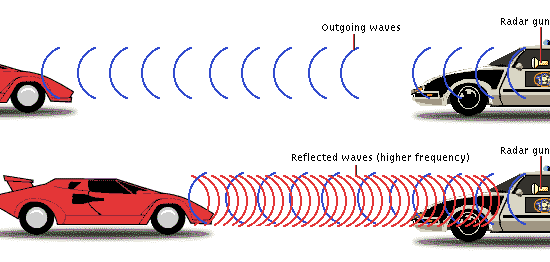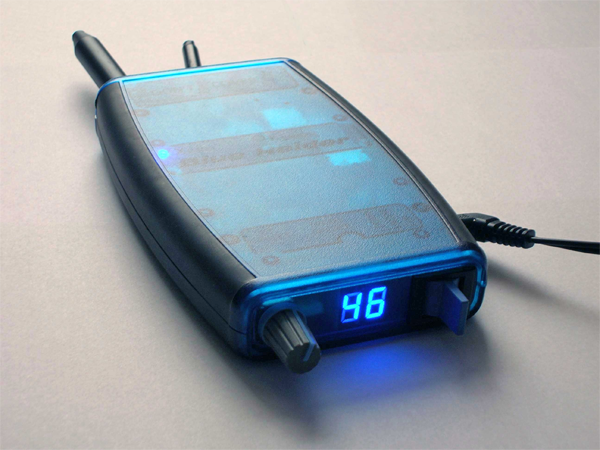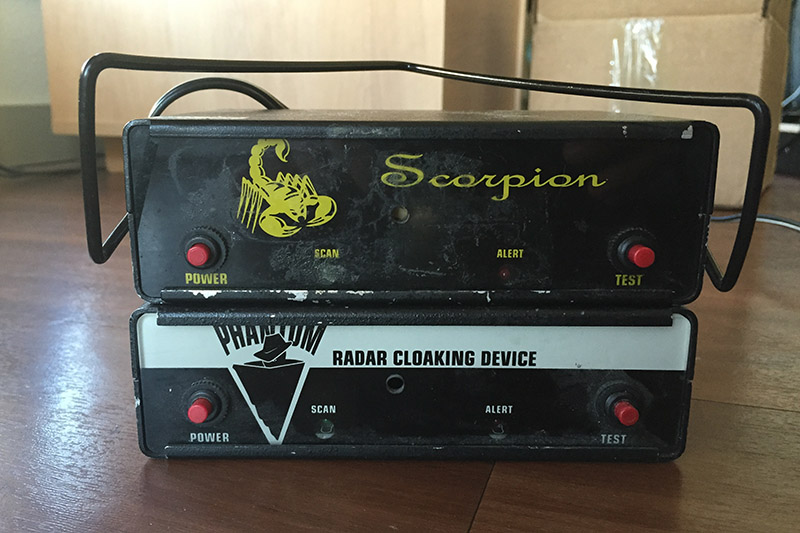Contents

How Does a Police Radar Jammer Work?
When it comes to jamming radar, there’s several different techniques available.
One, you could simply blast out so much “junk” radar that it overwhelms the radar gun’s receiver and it is unable to hear the actual return signal, thereby producing no radar. This would take a ton of power and modern radar guns typically have jam detection capabilities so no bueno.
Two, you could return a very similar radar signal that would trigger a fake speed on the radar gun, higher or lower than your actual speed. The radar jammer would listen for the radar frequency coming from the radar gun and generate its own output frequency, but doppler shifted to simulate a return signal from a vehicle moving faster or slower as desired. However, this depends on what direction you’re driving relative to the radar gun and often it would add the additional speed instead of subtract it, making it look like you’re actually going faster than you actually were, not slower. (Watch my video on how police radar guns work to learn more about the physics behind radar operation.)
However, there are several issues when it comes to turning radar jamming theory into reality including both legal and technical limitations.
Radar Jammer Laws
The biggest issue is that radar jamming is ridiculously illegal.
You’ve got The Communications Act of 1934 which states that both “prohibits willful or malicious interference with the radio communications of any station licensed or authorized under the Act or operated by the U.S. Government” (47 U.S.C. § 333) and “prohibits the manufacture, importation, marketing, sale or operation of these devices within the United States” (47 U.S.C. § 302a(b)).
Then in 1996, the FCC released an update explicitly prohibiting the jamming of police radar. Penalties for operating a jammer can exceed $100,000 and can include imprisonment. This also applies to jamming Wi-Fi, GPS, cell phones, and so on. When it comes to jamming various different radio-based devices including police radar, they mean business.
There used to be a few companies that developed and sold radar jammers back in the day, but the FCC went after them all and shut them down so there’s no longer any radar jammers being developed or sold in the US anymore.
Do Radar Jammers Work?
Radar jammers were built years ago in a time when radar guns were simpler. Jamming older analog police radar guns was much easier than jamming modern digital police radar guns, so they’re not useful in this day and age against the modern radar guns you’ll see on the road.
You’ve also got some serious legal issues when it comes to selling or operating a police radar jammer it’s not something you want to get involved with in any way.
When it comes to police radar, the best tool at your disposal is a good radar detector and if you’re looking to protect yourself from speeding tickets, that’s the way to go.
However, it can be interesting to look back at radar jammers from an educational / historical perspective so let’s take a look at some that existed years ago.
Active Radar Jammers
There’s fundamentally two types of radar jammers out there, active and passive.
Active jammers work by actively generating and transmitting a jamming signal out to the radar gun, preventing it from being able function properly.
Passive radar jammers don’t generate and transmit their own signal but rather reflect a modified version of the original signal.
Let’s take a look at examples of both types of jammers, starting with active radar jammers.
Blue Raider Radar Jammer
The first active radar jammer we’ll look at is the Blue Raider radar jammer.

Blue Raider radar jammer
The Blue Raider is a radar jammer built in Poland. It has a dial on the front that allows the user to dial in what speed they want the radar gun to see.
Here’s a demo of it in action at close range against an old Decatur Genesis series handheld radar gun.
You can also find videos of it in use overseas such as this clip of it being used to spoof fake speeds on an MRCD photo radar unit. You’ll see the operator parked along the side of the road and every time he raises up the Blue Raider radar jammer, the MRCD thinks it’s detecting a car speeding by and takes a photo so you’ll see the camera flash.
The Blue Raider isn’t designed for use in the USA, however. It doesn’t support radar frequencies in use in the US and it’s designed exclusively for close range operation against European photo radar, not longer range American radar guns. So the technology to jam exists, but it’s not something that would work here even if you wanted to use it.
Phantom & Scorpion Radar Jammers
Years ago, before all the FCC’s crackdowns, you could find radar jammers that were designed to jam American radar guns. Here are two active radar jammers that you used to find, the Phantom and Scorpion radar jammers.

Phantom and Scorpion Police Radar Jammers
The Phantom was the first model and it supported X band and K band only.
Eventually radar guns started migrating to Ka so the Scorpion was later developed and released, a radar jammer that supported X, K, and Ka band operation.
The idea was you’d put it on your dash and when it detects a radar signal, it would turn on, begin jamming the radar gun, and would prevent the radar gun from being able to acquire your speed.
These radar jammers showed a little promise early on, but they weren’t particularly effective, especially against the newer digital Ka radar guns, plus they would quickly fall out of tune and you’d have to physically keep recalibrating them via a set screw inside the unit.
As radar guns became more advanced and with the FCC cracking down on radar jamming, radar jammers like the Phantom and Scorpion stopped being built, sold, and supported, so with the units continuing to fall out of tune, they’re little more than museum pieces at this point.
Passive Radar Jammers
The radar jammers we’ve talked about so far are called “active” radar jammers because they actively generate and output a jamming signal.
Passive radar jammers, on the other hand, simply reflect back a modified version of the original radar signal. However, this doesn’t work at all, but there are companies who will sell you a passive radar jammer regardless.
Rocky Mountain Radar
Rocky Mountain Radar is a radar detector company that advertises passive jammer-like functionality that they call “scrambling.”. They claim that when they sense the radar signal, they add some additional information to it and reflect back a modified signal without generating anything on their own in an attempt to bypass the FCC’s regulations on actively transmitting jamming signals.
However, this doesn’t hold up in court and RMR has been found guilty of violating the FCC’s rules on radar jamming. RMR has tried appealing this decision several times but it always gets shut down. Nevertheless, RMR continues to sell products online advertising their same scrambling functionality.
Another big issue about RMR is that their scrambling technology is completely ineffective. They attempt to explain it with a bunch of nonsensical technobabble in an attempt to confuse and ultimate deceive potential, making their products sound like they have some competitive advantage, but in reality they sell a product that doesn’t work while engaging in unethical business practices.
They also make a lot of false claims about laser scrambling, RDD undetectability, POP detection, and so on, and you can see more in my Rocky Mountain Radar Judge Review, but let’s just focus on just the radar scrambling capabilities. We’ll look at their previous top of the line, the RMR C495, as well as their current top of the line unit, the RMR Judge.
RMR C495 Radar Scrambling Test
Here is the C495 tested against 5 different police radar guns including the MPH Bee III, MPH Z35, Kustom Falcon HR, Stalker ATR, & Stalker II. You’ll see that it has zero impact on any of the radar guns.
RMR Judge Radar Scrambling Test
Next let’s look at their current top of the line scrambling unit, The Judge. I’ve tested it against 6 different K and Ka band radar guns including the MPH Bee III, Stalker II, Decatur Genesis II, MPH Z35, Kustom Falcon HR, and Decatur Genesis II Select, and again you’ll see that it doesn’t have any impact on any radar gun.
So this so-called “scrambling” functionality is completely bogus. Rocky Mountain Radar is considered to be one of the biggest scammers in the radar detector industry. They attempt to make their products have a competitive advantage by deceiving their customers with false advertising, backed by a bunch of intelligent sounding nonsensical technobabble.
Stay away from Rocky Mountain Radar. Their products do not prevent police radar guns from obtaining your speed while driving in any way.
Radar Jammer Conclusion
Radar jammers are not a good tool for avoiding speeding tickets while driving. There’s big technical challenges to doing it successfully, there’s huge legal limitations and penalties you’d be looking at, and there are no radar jammers that even work in the first place against American radar guns.
If you’re looking to avoid radar-based speeding tickets, your best tool is a good radar detector. For help with picking a good radar detector, see my guide covering the best radar detectors on the market.
| This website contains affiliate links and I sometimes make commissions on purchases. All opinions are my own. I don’t do paid or sponsored reviews. Click here to read my affiliate disclosure. |


9 comments
Skip to comment form
This article makes no sense. You claim radar jammers cannot jam radar but yet they are illegal. Why would a useless box be illegal if it wasn’t a threat. The Phantom and Scorpion ceased all sales after the FCC knocked on their door not because their product didn’t work.
Author
They worked against some older radar guns, but not so much against the newest ones and they regularly fell out of tune and stopped working.
I can’t remember the model, but in 1992 I had an active radar jammer installed on an Integra, and it really, really, really worked. It was paired with a big Escort, and there was a threshold you could set for signal strength that would trigger the jammer, which was a white noise emitter with a range of almost 2 miles.
I think I used it for a “Smokey and the Bandit” run from Dallas to Milledgeville at something like 95 mph.
The fun stuff occurred when you’d cycle the Escort, turning it off, and then back on, on the highway. EVERYONE with a radar detector would get an instant signal, and you could see brake lights light up all the way to the event horizon.
The purchase was super-sketch. I had to fly to Houston-Hobby airport and meet the guy in the terminal. He wouldn’t mail it. I then turned around and flew right back on the SWA shuttle.
The unit cost about $600, and I had to get another shady installer to perform the install.
The company disappeared around 1994, and I never pulled the unit out of the car when I sold it to my cousin. I have no doubt that it originally worked (dodged several close calls in Virginia), but yeah, it was illegal as hell and I’m sure it went out of tune, and never worked on Ka, which was becoming the norm, along with laser systems.
Remember the stealth bra? That was a fun experiment…….
Thanks for the write-up. With traffic being what it is nowadays, I seriously doubt that speed control via radar is really valuable, outside of small communities that use state highways as revenue sources and means for existence with their Barney Fife PD’s.
I had the same one! I even tested it with a small-town friend police. I rolled in at 65 in a 25 zone. He said his radar flashed 65 but it just went fuzzy and he s
couldn’t lock my speed! loved following a pimp with a cowboy hat in a caddie. All the way through Nebraska every time he got to far ahead of me, id plug my jammer and laugh the whole way across the state as he jammed his brakes! Great Memory.
Old article but have to put my two cents in. You state that passive jammers can’t work IE sending back a signal to register a different speed on the gun, that is incorrect the math is there. Long technical read.
https://link.springer.com/article/10.1007/s11432-007-2017-y.
But yes for a normal citizen to research and development, prototypes ETC. would be cost prohibited, but it can be done with current technology in 2018.
Author
In the article I’m referring to current implementations of passive radar jammers. I can certainly see other products and/or implementations working better. 🙂 Thanks for the link.
I’ve got the scorpion. Can’t jam K any more but damn effective against X band.
You could give it a try in one of the smaller Po-Dunk Sheriff towns that still use X-Band. Ohio still uses X-Band as well as Cocoa Beach FL. There are a few others. Would love to see the pull over on you tube 🙂
Would you consider selling your jammer unit
JOEBBARTLETT@Yshoo